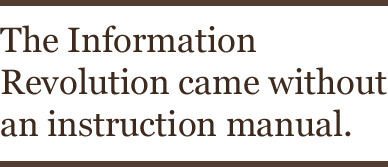Last year, I flew to Singapore to join Malcolm Gladwell, Marc Ecko and the graphic designer Stefan Sagmeister in addressing a group of advertising folks on “Marketing to the Child of Tomorrow.” Soon after I arrived at the Crowne Plaza next to Changi Airport’s Terminal 3—some of the conference’s guests had flown in that morning, would attend the day’s events and then fly home without ever really leaving the airport—the C.E.O. of the agency that had invited us took me aside. What he was most interested in, he began—I braced myself for mention of some next-generation stealth campaign—was stillness.
A few months later, I happened to see an interview with the perennially cutting-edge designer Phillipe Starck. What allowed him so consistently to remain ahead of the curve, he was asked? “I never read any magazines or watch TV,” said Starck, perhaps a little hyperbolically. “Nor do I go to cocktail parties, dinners or anything like that.” He lived outside conventional ideas, he implied, because “I live alone mostly, in the middle of nowhere.”
Around the same time, I noticed that those who part with $2285 a night to stay in a clifftop suite at the Post Ranch Inn in Big Sur pay all that partly for the privilege of not having a TV in their rooms; the future of travel, I’m reliably told, lies in “black-hole resorts,” which charge high prices precisely because you can’t get online or find cell-phone coverage in their rooms.
 Has it really come to this? In barely one generation we’ve moved from exulting in the time-saving devices that have so expanded our lives to trying to get away from them. Often in order to make more time. The more ways we have to connect, the more many of us seem desperate to unplug. Like teenagers, we appear to have gone from knowing nothing about the world to knowing too much all but overnight.
Has it really come to this? In barely one generation we’ve moved from exulting in the time-saving devices that have so expanded our lives to trying to get away from them. Often in order to make more time. The more ways we have to connect, the more many of us seem desperate to unplug. Like teenagers, we appear to have gone from knowing nothing about the world to knowing too much all but overnight.
Internet rescue camps in Korea and China try to save kids addicted to the screen, while cafes at home put up signs advertising, “No Wi-Fi.” Writer friends of mine pay good money to get the Freedom software that enables them to disable (for up to eight hours) the very Internet connections that seemed so emancipating not so long ago. Even Intel (of all companies) experimented in 2007 with conferring four uninterrupted hours of “Quiet Time” every Tuesday morning on 300 engineers and managers (the average office worker today, studies have found, enjoys no more than three minutes without interruption). During this period the workers were not allowed to use the phone or deal with e-mail, but simply had the chance to clear their heads and to hear themselves think. The majority of Intel’s trial group recommended that the policy be extended to others.
At this point, the average American spends more than eight and a half hours a day before a screen, Nicholas Carr notes, in his eye-opening book The Shallows, in part because the number of hours American adults spent online doubled between 2005 and 2009 (and the number of hours spent in front of a TV screen, often simultaneously, is also steadily increasing). The average American teenager sends or receives 60 texts a day, though one girl in Sacramento managed to handle an average of 10,000 every 24 hours for a month. Since luxury, as any economist will tell you, is a function of scarcity, the child of tomorrow, I heard myself tell the marketers in Singapore, will crave nothing more than freedom, if only for a short while, from all the blinking machines, streaming videos and scrolling headlines that leave her feeling empty and too full all at once

